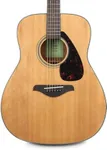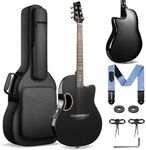Buying Guide for the Best Yamaha Guitars
Choosing the right Yamaha guitar can be a rewarding experience, but it requires some understanding of the key specifications that differentiate one model from another. Yamaha offers a wide range of guitars, from acoustic to electric, catering to various playing styles and skill levels. To find the best fit for you, consider your playing style, the type of music you enjoy, and your level of experience. Here are some key specs to help guide your decision-making process.Body TypeThe body type of a guitar affects its sound and playability. Yamaha guitars come in various body types such as dreadnought, concert, and jumbo for acoustics, and solid, semi-hollow, and hollow for electrics. Dreadnoughts are known for their bold, loud sound, making them great for strumming and flat-picking. Concert and jumbo bodies offer a more balanced tone, suitable for fingerpicking and softer playing styles. Solid body electrics are versatile and suitable for a wide range of music genres, while semi-hollow and hollow bodies provide a warmer, more resonant sound, ideal for jazz and blues. Choose a body type that matches your playing style and the sound you prefer.
Wood TypeThe type of wood used in a guitar's construction significantly influences its tone. Common woods for Yamaha guitars include spruce, mahogany, rosewood, and maple. Spruce tops are popular for their bright, clear sound and are often used in acoustic guitars. Mahogany offers a warmer, more mellow tone, making it great for blues and rock. Rosewood is known for its rich, complex overtones, while maple provides a bright, articulate sound. Consider the type of music you play and the tonal qualities you prefer when selecting the wood type.
Neck ProfileThe neck profile refers to the shape and thickness of the guitar's neck, which affects comfort and playability. Common neck profiles include C-shape, V-shape, and U-shape. C-shape necks are rounded and comfortable for most players, making them a versatile choice. V-shape necks have a more pronounced ridge, which some players find easier for thumb-over playing styles. U-shape necks are thicker and provide a solid grip, suitable for players with larger hands. Choose a neck profile that feels comfortable in your hand and suits your playing technique.
Scale LengthScale length is the distance between the guitar's nut and the bridge, affecting string tension and playability. Yamaha guitars typically have scale lengths ranging from 24.75 inches to 25.5 inches. Shorter scale lengths (around 24.75 inches) result in lower string tension, making the guitar easier to play and bend notes, which is ideal for blues and rock. Longer scale lengths (around 25.5 inches) provide higher string tension, offering a tighter, more articulate sound, suitable for genres like metal and jazz. Consider your playing style and the feel you prefer when choosing a scale length.
ElectronicsFor electric and electro-acoustic guitars, the type of electronics can greatly influence the sound and versatility. Yamaha guitars may come with single-coil, humbucker, or piezo pickups. Single-coil pickups produce a bright, clear sound, ideal for genres like country and pop. Humbuckers offer a thicker, more powerful tone, reducing noise and feedback, making them great for rock and metal. Piezo pickups are used in electro-acoustic guitars to amplify the natural acoustic sound. Consider the type of music you play and whether you need the guitar to be amplified when choosing the electronics.
FinishThe finish of a guitar not only affects its appearance but also its sound. Common finishes include gloss, satin, and matte. Gloss finishes are shiny and durable, providing a bright, reflective look, but can sometimes dampen the guitar's resonance. Satin finishes offer a smooth, less reflective surface, allowing the wood to resonate more freely, resulting in a warmer tone. Matte finishes are non-reflective and provide a natural look, often preferred for their minimal impact on the guitar's sound. Choose a finish that appeals to your aesthetic preferences and consider how it might affect the guitar's tone.




















